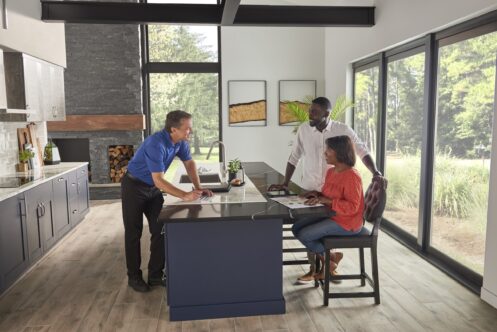New HVAC Systems: How to Choose the Right One for Multistory Homes

Getting the right HVAC system for your home is important for your family’s comfort and reducing heating and cooling costs. However, those challenges compound when you’re dealing with a multi-story home because of how heat rises and trying to effectively circulate conditioned air through multiple levels. This guide will explore the HVAC systems typically considered for homes in central Illinois, getting the right size, what to consider about HVAC efficiency and advanced practices for comfort control.
HVAC Options
While there are nearly infinite options for keeping your home comfortable, full HVAC systems tend to be the most cost-effective. These systems usually have a larger heating or cooling unit and then a way of delivering conditioned air throughout your home. The two most common options are central systems, that rely on a central air handler, or ductless mini-split systems.
Central
Central HVAC systems have a central air handler that delivers heated or cooled air throughout your home using a system of ductwork. To work effectively, this must have both ducts that supply the conditioned air and ducts bringing air back to the system to condition. The most common setup is a central air conditioner and natural gas furnace. However, central HVAC systems can also use heat pumps, including geothermal units. The challenge with central systems for multi-story homes is getting enough conditioned air to the furthest parts of the house away from the system, usually on the upper floor.
Ductless
Ductless systems are also referred to as ductless mini-splits and use small air handlers that usually mount to exterior walls around your home rather than a single large central air handler. In multi-story homes, you’d typically plan for at least one air handler per floor.
You can only use ductless systems with heat pumps, and they can work with geothermal systems and are typically only used in homes where ducts are not already installed. You’ll need a geothermal system if you plan to use it as a primary heating source being air-sourced heat pumps lose their efficiency and effectiveness in frigid temperatures. This is, of course, unless you have a backup heat source, such as a heat strip.
System Size
Getting the proper system size is imperative for keeping your entire home comfortable. A small system will leave most of your home uncomfortable while making the system run extraordinarily long heating and cooling cycles. Conversely, an oversized system will short cycle, causing excessive wear, driving up your energy costs and still leaving you uncomfortable. In addition to heating and cooling capacity, usually measured in British thermal units (BTU), you also need sufficient air movement to push conditioned air to the upper floors. This may mean needing a larger circulating fan than what you may find with an otherwise properly sized system.
System Efficiency
How HVAC efficiency is measured depends on whether you’re discussing a refrigerant system or a fuel-burning system. For heat pumps and air conditioners, the efficiency is measured using Seasonal Energy Efficiency Ratio (SEER) for cooling and Heating Season Performance Factor (HSPF) for heating. These both compare the amount of energy consumed versus the amount of heat transferred. Furnaces use Annual Fuel Utilization Efficiency (AFUE), which compares the amount of heat produced versus what’s lost in exhaust.
Generally, higher efficiency is good. However, when dealing with a multi-story home with a central system, you should plan to lose some of that efficiency as the air has to travel further from the system. This is one benefit of ductless geothermal systems because the air is conditioned right at the location you want to heat or cool.
Advanced Comfort Control: Zoning
Zoning refers to the practice of splitting your home into smaller areas to condition. This ensures that each area is getting the conditioning needed, improving heating and cooling efficiency. Ductless systems do this naturally, with each air handler conditioning its zone.
Central systems can also leverage zoning by using automatic dampers in the ducts. Each zone has a temperature sensor or thermostat of its own. That control unit then opens the damper when the zone needs conditioning while keeping it closed when it doesn’t. This ensures that the conditioned air is getting to the areas needing it, allowing for more evenly distributed and energy-efficient heating and cooling. For multi-story homes, zones can also help reduce the circulating capacity needed for the air handler.
Our Trustworthy Team Can Help
Rather than guessing at a random service company, property owners around Paxton turn to Dogtown Heating, Air & Plumbing when they need home services. Our team provides trusted heating and air conditioning installation, maintenance and repair, indoor air quality solutions and residential plumbing services including fixture installation and repair, water heater installation and repair, drain cleaning and repair, garbage disposal installation and repair and pipe repair.
Call to schedule a consultation with one of our NATE-certified HVAC installation professionals today.

